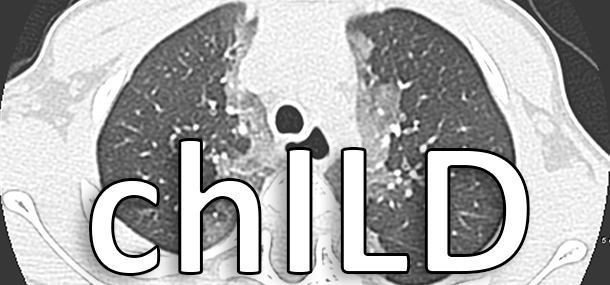
Both lungs are affected in children with chILD, or childhood interstitial lung disease. This is different from diseases we see more often such as pneumonia, which affect only one part of the lung. ChILD is rare, lasts a long time, and includes a wide range of diseases, from those that improve on their own to more severe types that cannot be cured and require a lung transplant.
The most common symptom of chILD is fast breathing. The first imaging test when chILD is supected is usually a chest x-ray. Often a visit to the doctor’s office and a chest x-ray are all that’s needed to show that something else is going on, and that your child doesn’t have chILD (sometimes child and chILD get confusing!). If there are still questions, a CT scan is usually the next imaging study. CT scans done at Cincinnati Children’s are designed especially for children to make sure we get good pictures using the lowest dose. Experts agree that the risk of a CT scan is much, much smaller than the benefit from helping to find out what’s wrong with a sick child.
Cincinnati Children’s is one of the leaders in caring for children with chILD. We’ve learned so much in the last few years; below is just one example of how that knowledge has helped us to improve care.
About 10 years ago a little girl came to Cincinnati Children’s because she was breathing fast. She had been in and out of her local hospital several times. Her CT scan was abnormal, but we hadn’t seen that picture before and no one knew what it meant. She had surgery for a lung biopsy, where a small piece of lung was removed so it could be studied under a microscope. After all that, we still didn’t know exactly what was wrong. Our lung doctors continued to care for her, and we were happy to see that over the next few years she didn’t get worse, and even got a little better.
Last year a 2 ½-year-old boy came to see our lung doctors because he was breathing fast and didn’t have enough oxygen in his blood. We performed a chest x-ray and a CT scan. His picture looked almost the same as the girl we’d seen 10 years before, but over those 10 years we’d learned a lot. Without a biopsy, just from the CT scan, we could tell the family that he had a disease called neuroendocrine cell hyperplasia of infancy. Much more important than a name, we told them that it would probably take a long time, but he would slowly improve without the need for special medicines. The lung doctors told them that out of hundreds of children none had died from this disease.
Because of the research we and others had done, we could let the family know what was wrong and what to expect. We could tell his doctor how to take care of him. He’s still using oxygen, but he’s in preschool and doing great.
It’s important to remember that a normal imaging study is often a big help. If your doctor knows that some things aren’t the cause of your child’s problem, he or she can concentrate on the things that still might be the cause.
 Contributed by Dr. Alan S. Brody and edited by Sarah Kaupp (RRA).
Contributed by Dr. Alan S. Brody and edited by Sarah Kaupp (RRA).